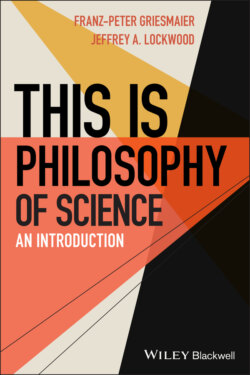Читать книгу This is Philosophy of Science - Franz-Peter Griesmaier - Страница 16
1.2.3 Inference to the Best Explanation (IBE)
ОглавлениеThis form of inference is exemplified by the story of caloric. The idea is that we observe some regularity and then postulate one or more mechanisms (or entities) that could be responsible for the observed regularity. If we can come up with just one, and it strikes us a plausible, we call it a day and accept it (this simplification will be corrected momentarily). If there is more than one, we look for the explanation which strikes us as best. To see what’s going on here, look at the following example, inspired by philosopher Elliott Sober.2
Suppose you are sitting in your living room and suddenly hear strange noises coming from your attic – a quick succession of what sounds like little taps and then a rumbling noise. You consider two hypotheses: First, the noise is produced by gremlins from outer space that have landed on your roof and are now bowling in your attic. Call this hypothesis G. Second, the noise is produced by the neighbor’s cat, which got into your attic and is trying to catch mice, but keeps running into the books you have stacked up there. Call this hypothesis C. Clearly, C is better than G, although G is an explanation of sorts: If it were true, then the probability of hearing those noises would be quite high. However, the same is true of C, and since C is more plausible than G in light of all the other things you believe, C is clearly the better explanation. You then infer that the best explanation is the most probable one and thus accept C. You have inferred the best of the explanations under consideration; this is IBE.
Several things are worth commenting on. First, both G and C make the observation probable – both bowling gremlins and mouse-chasing cats could produce those noises you hear. Second, both C and G might be false. Maybe it’s neither cats nor gremlins, but it’s some neighborhood kids playing a practical joke. Third, and related to the last point, what hypothesis counts as the best is partially determined by which ones you can come up with. In other words, the best hypothesis from among those we thought of need not be a very good one, all things considered. Often, we miss an even better hypothesis, as we know from the history of science and discuss further in Chapter 12. In fact, the history of scientific progress is one of not only gathering more evidence but improving explanations such that was once the “best” is supplanted by something better.
Thus, even if you are very creative in generating hypotheses, you might generate really awful ones and shouldn’t believe any one of those. This has prompted some to eschew the use of IBE altogether, especially insofar as it pertains to unobservables (things we can’t directly see or otherwise sense, such as electrons or magnetic forces). In short, IBE can provide some reason for accepting a claim (we use it in forensic sciences all the time, for example, when we try to find the person whose presence is the best explanation of all the clues, and infer that the person who best fits the clues is the perpetrator), but it certainly doesn’t guarantee our knowing the truth.
Finally, it is important to point out that IBE cannot be reduced to other forms of inductive inference. Inferring the presence of a stray cat in my attic as the best explanation of the noise I am hearing does not (need to) involve prior observations of stray cats in my attic and their behavior. Thus, this inference is different from a statistical inference, which, if you recall the example of koalas, does rely on observations of the feeding habits of a number of koalas to infer something about what other koalas will eat. Neither am I trying to establish any sort of regularity when I infer that a cat must have gotten into my attic. I am simply interested in explaining this particular and odd event by evaluating various hypotheses as to their plausibility in light of my background knowledge about cats, none of which I need to have oberved in an attic.
Let’s recap what we discussed in this section. We distinguished between conclusive and defeasible reasons. Along with that distinction comes another one, namely, the distinction between deductive and inductive reasoning. The former can be characterized as an inference from the implicit to the explicit, while the latter is an inference from the observed to the unobserved. The following diagram (Figure 1.1) shows the distinctions you should keep in mind:3
Figure 1.1 Forms of reasoning.
